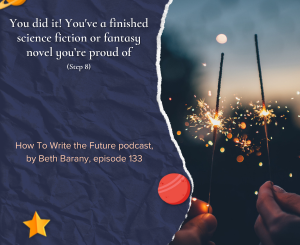How Do You Develop Your Characters? Part 2
 I wrote about how I developed my character, Henrietta The Dragon Slayer, in my previous post here.
I wrote about how I developed my character, Henrietta The Dragon Slayer, in my previous post here.
Today I thought I’d reflect on one of the biggest challenges I see in the manuscripts I edit, and even in some books I read: character motivation.
If I can’t relate to your character, if I don’t “get” her, it’s probably because I don’t understand where she’s coming from.
So some questions to ask:
- Why does your character want that thing?
- Then ask, what will having that do for her? To whatever surfaces, ask this question a few times until you get to a core fundamental desire: like safety, to be loved, to have purpose. (This question comes from NLP — Neuro-Linguistic Programming.)
- What specific life experience created that motivation for your character?
- What is the secret your character is running from and won’t admit to herself?
When I first presented Henrietta to my critique group, they didn’t like her. Really, they didn’t understand her. As soon as I showed where she came from and what she was running from (You’ll have to read it to find out!), and dropped little hints about her past, they “got” her and liked her. Whew!
How do you develop your characters?
Thanks for your tips!







Funny that you should be writing about this. I just posted about the creation of one of my characters on my blog (http://stephendagostino.com/2011/08/16/making-fiction-out-of-history/). This character is a lawyer who, in defending the protagonist and his family and neighbors, gets a second chance to fight a legal battle he lost 30 years before (his motivation).
The people who have read about this character really like him. They call him a Jimmy Stewart-like character, and they love his theatrical nature of presenting arguments.
I love him for all of that and for the fact that I was able to model him after a real character whose name just begged for inclusion in my novel.
-Stephen
Oddly enough, in the genre I write, which is Oz, I got criticized heavily in my first book, Magician of Oz because I spent 8 of 28 chapters fleshing out the characters which would play a major role in the story before they ever got to Oz. L. Frank Baum used a formula that goes like this: Get to Oz asap, have the adventure, then get out or move on. There was never any character development. When I did it, Oz folks went weird and complained endlessly. Now, following Shadow Demon of Oz and Family of Oz, most folks get it and tend to appreciate the character development, which is the critical defining aspect of my work, IMHO.
Stephen, i read your post. I like how you made your character’s motivation stronger. I’m curious about your book! Thanks for stopping by!
James: You took a big risk, and now it seems to be paying off! Wonderful!
I do character bios on mine- likes, dislikes, who they grew up, etc. It helps me keep their motivations clear. Sometimes we don;t like characters right away it’s a great author that can make us love them by the end of the book.
Alica: Character bios are a great tool. It is a great author that can make us love a character by the end of the book, so in the meantime, we need to help them fall in love with character. Otherwise, why read?
I ask them about themselves and I listen, even to the bits I don’t like. I ask them why they want what they want, so it comes from them, not me. That makes the process and the characters more interesting than if I came up with it all via a thought process.
Tahlia, Love your process! I do that, too. It can be rather surprising what my characters reveal.